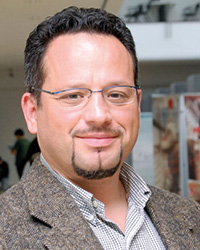Paola Fusi interviews Giuseppe Riccardi
In the referendum on 23 June, the United Kingdom voted in favor of leaving the European Union. Around 17 million British voters (52% of those who voted) chose to leave the EU, a surprise to almost everyone given the results of surveys and exit polls and the general expectation that the ‘Remain’ option would win. An unexpected result, but not for everyone.
We talked with Giuseppe Riccardi, associate professor in the Department of Information Engineering and Computer Science and coordinator of the project SENSEI (Making Sense of Human - Human Conversation).
 Professor Riccardi, the result of the referendum of 23 June in the United Kingdom took almost everyone by surprise. Had you expected this result? Why?
Professor Riccardi, the result of the referendum of 23 June in the United Kingdom took almost everyone by surprise. Had you expected this result? Why?
For those of us who work in the SENSEI research project it wasn’t a surprise. Our data gave us ‘Leave’ at 51,79%.
In the month leading up to the referendum, the project’s website (http://www.sense-eu.info/) gave a constantly updated visualization of the trends in public conversations online, through an analysis of over 300 thousand conversations a day (reaching a peak of a million in the last days) from over 4 thousand different sources in the major European languages.
Sources included the most popular social networks, such as Twitter, the most prestigious newspaper websites, and blogs on the topic. The system analyzes conversations in several languages, and identifies the posts with the most followers and comments on the topic at a global level. But in particular it shows, in real time, whether the orientation of the conversations on the newspaper websites, on blogs, and in conversations in English on social networks is for or against the EU – a mirror of the potential vote.
What is SENSEI and what are its strengths?
It’s a research project financed as part of the European Commission’s 7th Framework Programme. It aims to design, evaluate and implement a new method of analyzing conversations on social media and information sources, in order to extract in real time information that is important and useful, as we have seen on this occasion, for politicians, commentators, journalists, and last but not least, for citizens themselves.
This project is unique in the objectives that it has set, to develop a technology for the analysis of conversations on various channels, from the telephone to social media, keeping in mind and including the final users at the design and evaluation stages. The technology is based on state-of-the-art computational linguistics techniques, machine learning, and human-machine interaction. The partners in the project are four of the most important European university research centers in this field, and leading companies in the area of conversation management in industry. The combination of our skills has allowed us to make significant steps forward from a technological point of view, and to unlock potential for profit and for understanding society, through the analysis of public conversations online.
 What role does the University of Trento play in the project and who are the other partners?
What role does the University of Trento play in the project and who are the other partners?
The University of Trento coordinates the project and manages the scientific and technological agenda. The other partners are the Universities of Aix-Marseille, Sheffield, and Essex. The industrial partners are Teleperformance (world leader in contact centers) and WEBSAYS (SME, Barcelona). Each partner is a world leader recognized for their skills in computational linguistics, machine learning, human-machine interaction, or services and technologies for both national and international companies in the multi-channel world (telephone and social media).
What other applications are possible? Are there opportunities for commercial use or technological transfer of the results of this research?
I would say that both the monitoring of the Brexit referendum and the type of technologies used lend themselves very well to the needs of companies to listen to the conversations of their customers in order to know what they think, and to create new products. We have already been contacted by companies, which confirms this. I would also hope that the world of government and administration will explore this opportunity to talk with their citizens using the most advanced technologies. A small town in the south of Spain is trying this out.
What does it mean to receive European funding and to be coordinator of the project? How important is EU financial support for university research?
SENSEI is a European project chosen at the end of a very selective process (5-10% success rate) that lasted three years. The consortium made a big investment in terms of resources to draw up the grant application. But the opportunity to work together with the best universities and industries in Europe is both important and unique. In some cases it’s possible to obtain results and continue activities that go beyond the end of the project, with benefits for research activity and technology transfer.




